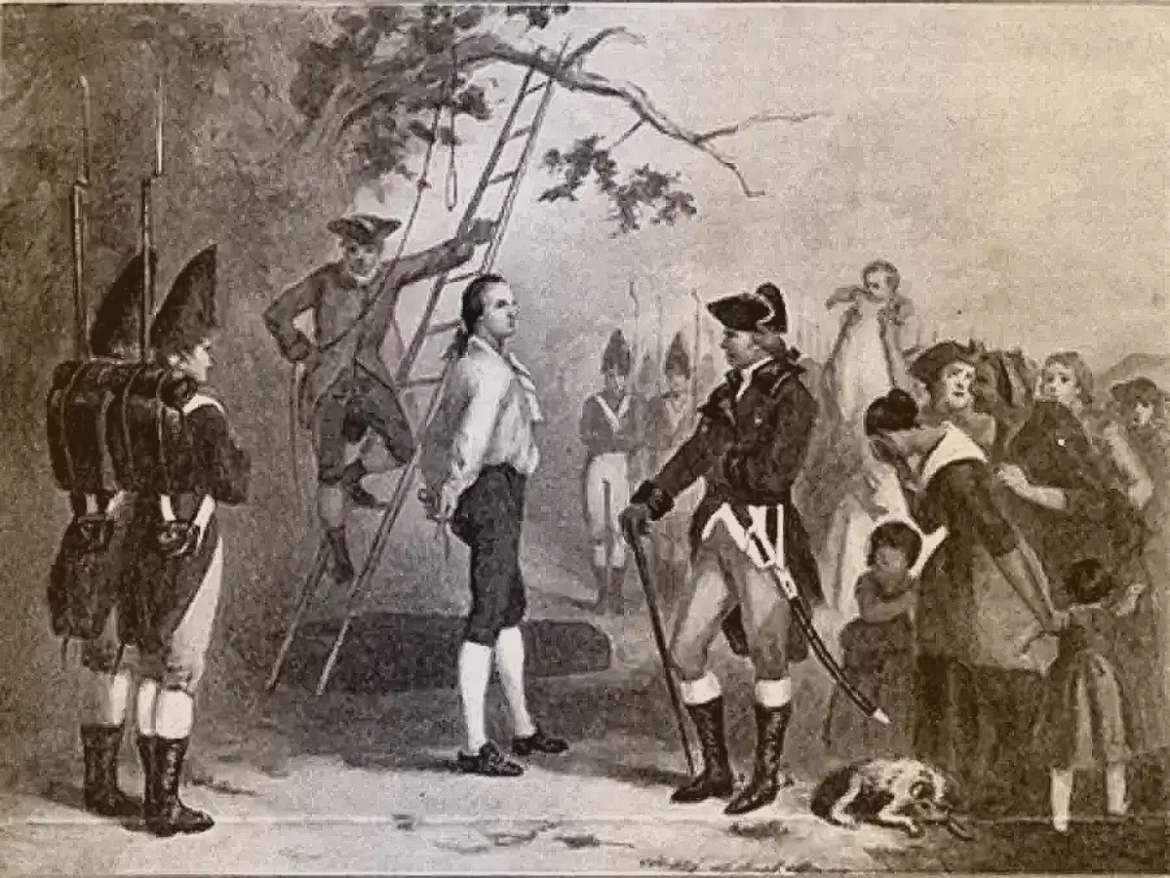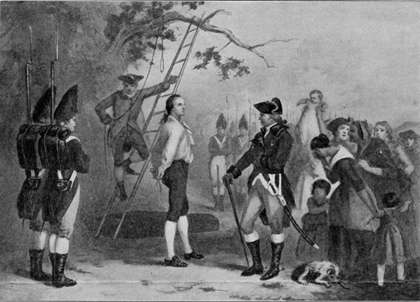More than two centuries after Nathan Hale was hanged, a sharp-eyed librarian discovered the hidden truth about his capture.
Nathan Hale has long been a legend, the martyred hero of the American Revolution. Librarian James Hutson found out that another legendary American tricked Hale into revealing his spy mission.
Hutson in 2000 was chief of the manuscript division of the Library of Congress when the library received an unexpected gem: a history of the American Revolution written by a Connecticut Loyalist, Consider Tiffany. The Tiffany family had held the manuscript for generations when G. Bradford Tiffany donated it to the Library of Congress.
And in that manuscript James Hutson learned that none other than Robert Rogers captured Nathan Hale.
Robert Rogers
Robert Rogers was an Indian fighter well known to this day for his daring exploits as commander of Rogers Rangers. Described as ‘subtil and deep as hell itself,’ Rogers was a master of deceptions and ambushes.
The U.S. Army Rangers adopted his rules for guerilla warfare. Kenneth Roberts celebrated Rogers in his novel, Northwest Passage, later made into a film starring Spencer Tracy.
Some people, like Thomas Gage, couldn’t stand Robert Rogers. He gambled and sold himself out as a soldier. After the French and Indian War ended, Rogers was tried for treason, but exonerated.
He ran up debts from his gambling and landed in prison. After his release he went to London to capitalize on his fame. Then in 1775 he returned to America, looking to sell his services to the highest bidder.
What Might Have Been
If George Washington hadn’t avoided Robert Rogers, Nathan Hale might have survived the war. Hale and Rogers were both in the Boston area during the Siege of Boston.
Rogers was staying in Medford, Mass., 20-odd miles from his birthplace.
Hale served with Connecticut forces besieging Boston. He befriended Washington’s comrades Israel Putnam and Charles Lee.
Rogers tried to get an appointment with Washington at his headquarters in Cambridge. Washington kept his distance and asked Gen. John Sullivan to interview Rogers in Medford. Sullivan talked to the guerilla fighter twice and advised Washington to shun him.
Rogers eventually ended up with the British fleet off the Long Island coast, because British Gen. William Howe commissioned him to raise a battalion of rangers.
Nathan Hale, Miscast Spy
Historians conclude it was folly to send Nathan Hale to Long Island on a spy mission.
First of all, he came from Connecticut. Many Connecticut Loyalists had fled the rebel government or wanted to fight for the British. Connecticut Tory Moses Dunbar, for example, went to the gallows after signing up with the British army on Long Island.
Secondly, Nathan Hale had a Loyalist cousin, Samuel Hale, who served as a soldier with General William Howe’s forces in the New York area.
Thirdly, Hale stood out in a crowd because of his unusual height and his face scarred by gunpowder burns.
Finally, Nathan Hale was a rank amateur. He knew nothing about espionage, had no training, no code words, no secret ink. He simply went as a sacrificial lamb to a place where a Loyalist would likely recognize him.
Consider Tiffany
Consider Tiffany was a storekeeper in Barkhamsted, Conn., and a feisty Loyalist. He spent 15 months under house arrest. During, or soon after, the American Revolution, Tiffany wrote a history of the war that he never published.
The Library of Congress wanted to acquire the manuscript, wrote Hutson. That’s because no good New England Tory histories exist describing the American Revolutionary period.
About Nathan Hale, historians had ‘very few nuggets of hard intelligence and a great deal of … outright speculation,’ according to Maj. Gen. E.R. Thompson, an intelligence historian.
All that was certain was that Nathan Hale went ashore on Long Island sometime in mid-September 1776 and disappeared. And three nuggets of information:
- An orderly book reported Hale was apprehended Sept. 21, confessed and was hanged on Sept. 22nd at 11 a.m.
- A diary entry by British Lt. Frederick Mackenzie reported on the capture of Hale on Long Island.
- A diary entry by Capt. William Bamford of the 40th Regiment of Foot, which surfaced in 1933, reported Maj. Rogers took Nathan Hale.
Also, Robert Rogers and his men hovered off the coast of western Long Island in 1776 from September 16 to 21, according to the log of the Halifax.
Capture of Nathan Hale
According to Tiffany, Rogers knew American spies on Long Island had a mission to learn if the Long Islanders sympathized with the patriots.
Rogers kept an eye on Hale, thinking him an enemy in disguise. Rogers put on his own disguise and visited Hale in his quarters. Then he told Hale he was troubled at being stuck on Long Island, where the inhabitants sided with the British. He suggested he wanted to spy on British troop movements.
The hapless Hale believed Rogers, his new best friend, and invited him to have dinner with him the next day. They met in a tavern, where Rogers brought three or four men who also pretended interest in spying for the Americans. As they talked, a company of soldiers surrounded the house and seized Hale. Hale denied his identity, but several Connecticut Loyalists recognized him. The British hanged him immediately without a trial.
So goes Consider Tiffany’s account of Nathan Hale’s capture. But should we believe it?
Wrote Hutson, it ‘fits the facts as we know them so well that one is tempted to accept it as being substantially true.’
This story about Nathan Hale was updated in 2023.





8 comments
A GOOD SOURCE ON ROGERS WOULD BE FOUND IN THE BOOK “WHITE DEVIL” BY STEPHEN BRUMWELL(WHO ALSO WROTE “REDCOATS”).
[…] knows the story of Nathan Hale, the young schoolmaster turned spy for George Washington. The famous Indian fighter Robert Rogers captured him on Long Island, and the British hanged him without a trial. The State of Connecticut considers him […]
[…] Nathan Hale is the first among all Connecticut’s military heroes, having given his life for his country. But no one ever found his body. […]
Its well documented that Robert Rogers was born in Methuen, Mass. Let’s try to be more accurate please.
Thank you for pointing out the error. We have corrected it.
[…] intelligence officer John Andre met his awful fate with courage much as his American counterpart Nathan Hale met his four years earlier. For Andre died on the gallows as a spy, though he probably wouldn’t […]
[…] intelligence officer John Andre met his awful fate with courage, much as his American counterpart Nathan Hale met his four years earlier. For Andre died on the gallows as a spy, though he probably would have […]
[…] Tallmadge, a former classmate of Nathan Hale, reported directly to Washington as head of the army’s intelligence gathering operation starting […]
Comments are closed.